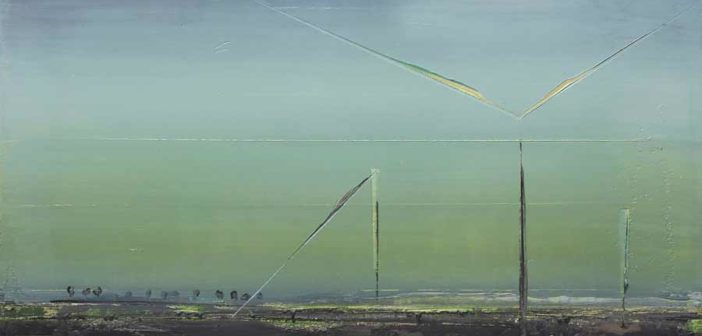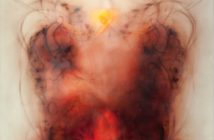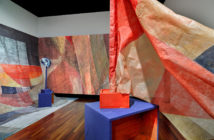Wilhelm Neusser and I first met in a roomful of paintings at an art auction. I asked him if he had a favorite of the works on view, and he began speaking about perceived intentions of many of the artists, their methods and how their imagery related to art history.
Studious elegance and kind wit are two of Neusser’s most obvious characteristics. Both were abundant during an interview in his Somerville studio, as we discussed his growing up in Germany, emigration to the United States and the biographical, cultural and technical components to his landscape paintings. The content and form of Neusser’s work are complex and sometimes cannot be entirely understood without close inspection, as imagery shifts and surfaces vary from thickly painted to barely glazed to partially scraped off or destroyed by tools. In many of the paintings there is an atmospheric yearning; across all of them is a sense that Neusser is using a particular genre for intentions greater than comforting reproduction.
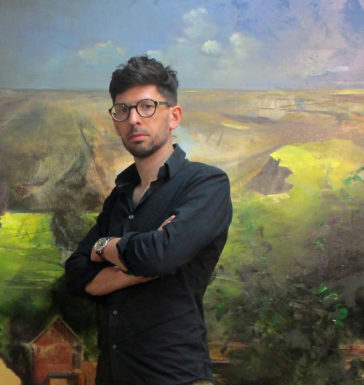
Wilhelm Neusser.
JIM: You and I have spoken a few times at length, but our conversations have tended to be about art and art history. I know you’re from Germany, and that you focus on landscape painting and not much more, though I admit to making guesses about you based on your work. Could we start this conversation from the beginning?
WILHELM: I grew up in a conservative, Catholic middle-class family outside of Cologne, Germany. My mother’s and father’s families came from an agricultural background. My father’s father was a farmer and a hunter; and even though my father became a lawyer, he kept very close ties to the landscape surrounding us. In our house we had paintings on the wall that were decorative, like a hunting dog carrying a pheasant, ducks on a little pond…. But there was also a painting by my grandmother of the farm where my dad had grown up before all the land around it went down to the coal mining industry. So the visuals that I grew up with were very much related to this family environment, not intellectual objects to look at and think about or discuss.
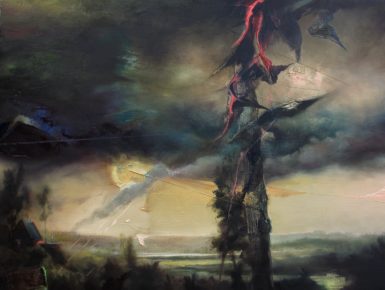
Untitled/Landscape (1531), oil on canvas, 24” x 32” (2015).
As a teenager I was interested in painting as something I could do with my hands. Living on the outskirts of Cologne, I could go to town where there was contemporary art. I mean this was, and still is, the town of Gerhard Richter, Sigmar Polke and Martin Kippenberger, and of the amazing Ludwig Collection. Step by step they informed my own painting experiments of the time.
Eventually I went to art school in Karlsruhe, at the Staatliche Akademie der Bildenden Künste, in the southwestern part of Germany, and then I moved back to Cologne where I worked for an auction house as an art handler. I was a driver between Berlin and Paris, and it was a really interesting thing because, after four years of art school where I was thinking about my own work, I got a completely different angle on the art world where objects were a commodity. Also, holding all the artwork in my hands, seeing it close up, was a great training for my eye.
JIM: Did the art you had grown up with and the art you encountered in the rest of the world set up any kind of tension?
WILHELM: Not so much. It’s my nature to see things next to each other and not make an either/or decision.
One artist I spent a lot of time looking at was Richter. He is a painter who throughout his work analyzes the boundaries of painting, but at the same time he’s very deeply rooted in a bourgeois German view of the world. Sometimes he paints the most boring things like a bunch of flowers, a landscape, a few apples that aren’t super-spectacular. But across his work he has consistency and an ability to touch on many different fields and thoroughly analyze them. Yeah, he explores as though he’s walking down a hallway, entering one room of painterly adventure after another and making careful decisions about what makes a work of art good.
JIM: Something I’ve asked myself while looking at your paintings is whether the history and appearance of the German landscape that I see in them are actually there. Am I reading too much of what I know about you into your work?
WILHELM: That’s a wonderful question. And if mine is a German landscape then what makes it that? I think some of what I grew up with is coming back more and more now that I’ve relocated to the U.S., and I wonder if it’s part of an adjustment process. What I paint now is a very specific type of landscape – a not necessarily super-attractive land that has been industrialized mostly by coal mining. As I mentioned, this is my family’s history. But that whole thing, that history, is only one of three elements that I focus on in my work. There’s my biographical landscape, and then there’s the historical German landscape, which is not personal but more a play on stereotypes and clichés. The third element I focus on is creating topographies on the canvas – crusts of paint – so that my material itself becomes a landscape. These days I’m aiming for moments when the three ingredients come together and become as tasty as possible.
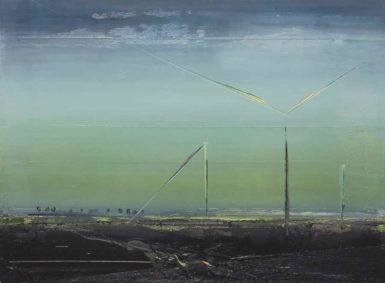
Bright Horizon (1534), oil on canvas, 12” x 14” (2015).
JIM: Your surfaces are intriguing. In one work you present a series of wind turbines on an open plain, apparently just after a rainstorm. My initial impression of the painting from a distance is of a well-done, straightforward piece of realism; but the impression becomes more complex as I approach it.. Approaching the painting visually changes it, and sets up a tension between a making a permanent representation of a landscape, which is inherently impermanent, and the painting process itself.
WILHELM: Right. In a compositional sense landscape paintings are hermetically sealed and intellectually suggest that places can stay in a certain state forever. A painted notion of paradise can be all yours, sure, but it’s also the beginning of the end of the painting and the subject. There’s a tradition of disrupting this notion by giving importance to the physical nature – the flesh and crust – of the painting itself.
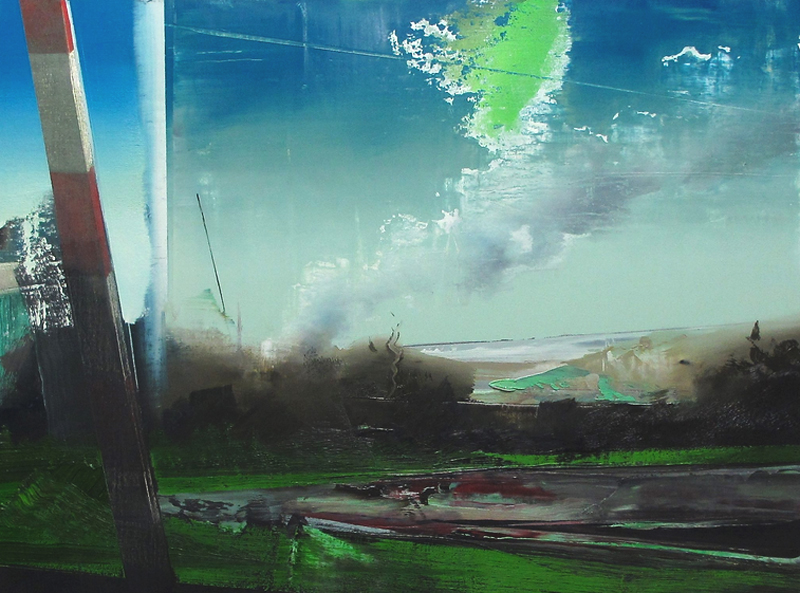
Landscape (1422), oil on canvas, 24” x 32” (2014).
What interests me is how illusion in a painting can overlap with physical surfaces and materials. In a piece like the one you just mentioned and in others the sky has a gradient of atmospheric distance but then it falls apart. The incongruence creates what I consider a beautiful kind of rip in the initial illusion, a dialectic between completeness and disintegration or between healing and destroying. Maybe there’s also the fear that you can’t reach any certain state of perfection, which is the actual nature of world.
JIM: And so you present, for instance, a collection of interlocking plains assembled into an appealing, rolling countryside. You gray out certain areas, crisscross lines into impossible perspectives and let paint wash down the surface of the canvas in ways that bring attention to the canvas itself. Sometimes your canvas has a beaten, worn-out quality.
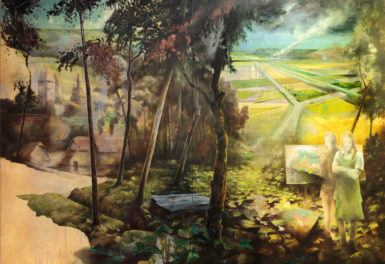
Landscape/Pastoral (1519), oil on canvas, 66” x 96” (2015)
WILHELM: It’s an intended experience. One of the recent new tools in my arsenal is a sanding bit and electric drill. I use them to sand down layers of paint to create structures that are not purposefully productive in terms of composition but purposefully destructive.
JIM: So you’ll build up many layers of paint and then sand them down to get a vivisection of what has accumulated. What becomes your goal then, to go back through geologies of paint?
WILHELM: There are those moments where I can have a really nice, sleek surface and enjoy it but for some reason it can’t be left like that. It’s a decision, one I have to make many times, of whether I should add on to what’s there and lose it to a certain extent or just leave it as it is. I normally decide to add on to it but then I have to attack it, and so I take out the sander.
By doing this, I create series of structures that might be partially covered with the next layer of paint. Hopefully this adds to a kind of canvas topography. What I’m thinking of here is translating an emotional or mental state onto the surface, rather than depicting something I’ve seen.
JIM: Grinding down through the geology of paint brings to mind your growing up among strip mines.
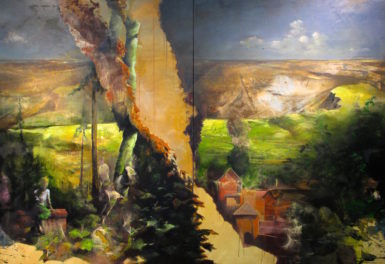
Lovers (1601), oil on canvas, 66” x 96” (2016).
WILHELM: Yes. And that brings us back to the biographical-landscape element of my work. The region I am looking at is west of Cologne. All over there are strip mines. They’re huge, constantly growing and slowly moving. What companies do is try to get to certain layers of coal by digging away at one side of the earth and building it back up on the other. As a hole slowly moves onward, little villages are eaten away and people move elsewhere to rebuild. What’s left are re-cultivated landscapes that are kind of natural looking but really 100% artificial. So, a mine eats the countryside and its history, then creates a new landscape and new history. We can discuss this politically or psychologically; for the people who live there it’s just their reality, and for many families, including my own, it has many effects. For instance, my father became a lawyer based, to a certain extent, on the fact that my grandfather’s farm was torn down as part of a mine project.
JIM: It got chewed up and spit out.
WILHELM: In a way, yes. And so the painting that I described early on by my grandmother depicting the farm is her interpretation of a landscape that’s not around anymore. When my dad and I would walk through the re-cultivated landscape he’d say, this is where the farm was, where the river with the water mills and the castle and everything else was. That was his childhood memory and his own nostalgia projected onto the landscape. All of that is part of my sense of the biographical landscape. When I work on paintings like this, all of it returns to me.
JIM: Why landscape painting?
WILHELM: Well, it sometimes seems that there’s not a whole lot you can do with it anymore. I mean, it has a very long tradition and has been used to a lot of ends. What I like about landscape as a painter is that it allows me to create a mood and atmosphere that resemble what’s in nature but that really we project onto it – particularly fear. And when I paint a landscape, a large one, the act of walking across the land and taking it in from different perspectives is exactly what I do in front of the canvas. It’s a metaphorical playground with references to hiking, overseeing and maybe gardening the earth.
JIM: My experience of being in a landscape is that the more time I spend in it the more incomprehensible it becomes. It’s partly intellectual, but it’s also based on the senses: everything heard and seen and felt is fleeting but part of what sustains us.
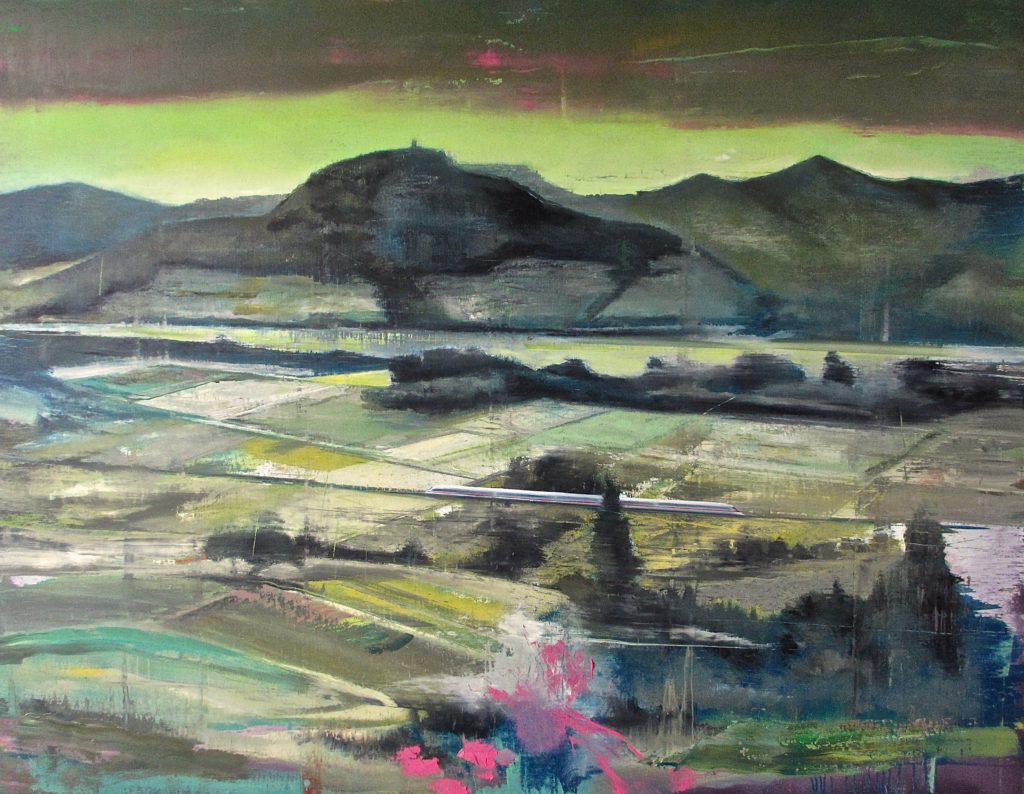
ICE (1408), oil on canvas, 54” x 72” (2014)
WILHELM: Something that fascinates me about a lot of landscape painting is this notion of the idyllic, which suggests there is a place where everything is good, a paradise that is supposed to stay that way. But landscapes are just the opposite. They are in constant movement but what we want is domestication, right? So in art we domesticate with our eye in terms of a composition. We build walls around everything to make sure that our little realms stay the same. And they don’t. Here there’s dialectic of harmony versus change, which are both realities but sometimes just in our hopes and dreams.
JIM: Could we talk about your decision-making process?
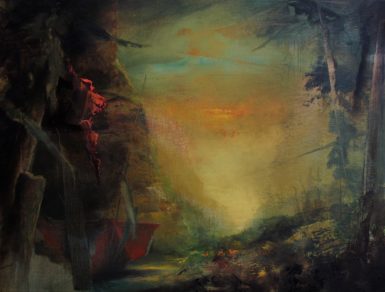
Untitled/Landscape (1532), oil on canvas, 24” x 32” (2015).
WILHELM: Well, the other night a friend came to my studio and he pointed out different areas where there was a very rich palate of structures, colors and so on. So we got into this discussion about how much information a painting actually needs. It’s a tricky thing.
I brought up an analogy to digital image files on our computers. When we zoom into a JPEG file, we quickly experience pixilation… information breakdown, very disappointing. I enjoy high resolution, where I can visually enter into an object’s deep tissue and find earlier layers of palimpsests. What I love to find in a painting is a character beyond the first impression. But then there’s this big question of how much pixilation I can put between clear information without losing the entire thing.
JIM: You bring a lot of risk to your own process. Is it ever nerve wracking to put a belt sander to something you’ve been working on, knowing that it could destroy everything including the canvas?
WILHELM: Yes it is nerve wracking, but my experience is that it’s always worth the risk – always. What it comes down to is believing that there’s a painting beyond the one I already have, something better. There isn’t an endpoint.
JIM: I don’t know that this would qualify as taking a risk, but lately you’ve been including human figures in your landscapes. And they don’t all seem to be present for the same reason. Some, for instance, ignore viewers and others engage them; some are serious and others jocular – or seemingly so. Is their point to add more of a narrative element to your work?
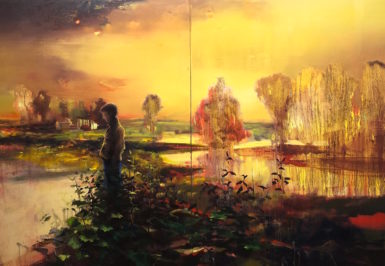
Untitled/Melancholia (1602), oil on canvas, 66” x 96” (2016).
WILHELM: For a long time I didn’t paint any figures into my work. In one of my most recent paintings, though, there’s a figure of someone taking a moment to look at something, to be lost in thought in a landscape that is somewhere between a warm, golden sunset and a nuclear catastrophe. So there is melancholy, loneliness and isolation, which can be read at the same time as satisfying solitude or as a scary final minute of living. Meanwhile, in another painting there might be a little artist at his easel, doing the same thing I was doing when I painted him. And then there is, um, the woman/man alter ego in a costume-y dress.
JIM: When I first saw a version of that alter-ego figure, with its blond pigtails and Pipi Longstocking dress, I figured it was a humorous cultural reference. It might still be that, but when I got up close to it I noticed that her face was your own. It then took on a psychological edge.
WILHELM: She or he is semi-inviting. I consider her or him to be kind of a narrator, or a transmitter between us and the landscape. It points out where we are, where the landscape is and how we might be able to get into it.
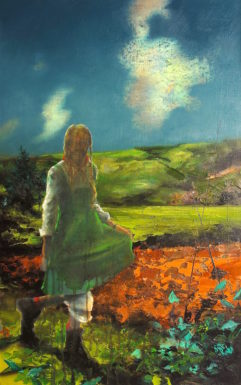
La Promenade (1522), oil on canvas, 32” x 20” (2015)
JIM: Last year your father died and I wonder if it has affected your painting, if it has injected a little bit of longing into it.
WILHELM: I think yes. When I was living in Cologne and near my family, I didn’t consider either very much. Moving here, I looked back and it was different. Then when my dad became sick and died, there was an emotional impact on looking back. Throughout this interview, when I’ve talked about the biographical ingredient of my work, I’ve meant it to mean something with geographical and emotional components to it. There’s no way to reconstruct some long-ago time, but incorporating a certain experience that I had and still have is part of my painting now. This isn’t about recreating a good old time but about visualizing my own experiences right now.
Living here between MIT and Harvard where everyone’s thinking about the next big game-changer in communications, financial services or whatever, where everything’s super-fast and super-visionary, I notice that my reaction is wanting to slow down. There’s an escapism that draws me away from this future-oriented high-speed world. I feel drawn to certain types of nostalgia even if sometimes I feel bad for it because it’s so retro in a negative or all too romantic way. But it’s healing and part of why I feel drawn to certain periods of painting. I’m obviously processing leaving behind a certain landscape and area of the world that had a huge influence on me. And this will sound cheesy, but you get to know what home was once you’ve left it.
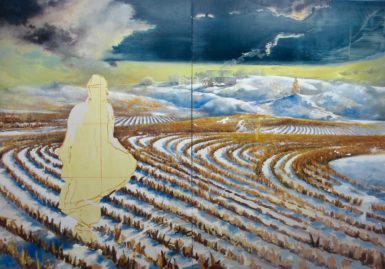
Escape (1607), oil on canvas, 66” x 96” (2016)

